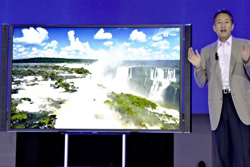Europe's online source of news, data & analysis for professionals involved in packaged media and new delivery technologies

4K TVs to gain marginal share of LCD TV market through 2017
Despite some high-profile product introductions, consumer demand for televisions with the ultra-high-definition 4K resolution will remain negligible for the foreseeable future, with shipments never accounting for more than 1 percent of the global liquid crystal display (LCD) TV market during the next five years.
Worldwide shipments of 4K LCD TVs will rise to 2.1 million units in 2017, up from 4,000 in 2012, according to a Television Market Tracker Report from analysts IHS iSuppli. Despite the large increase over the years, 4K will account for only 0.8% of the global LCD TV shipments by 2017, as presented in the figure below. The sets are known as 4K because the TV sets feature a pixel format of 3,840 by 2,160 - four times that of a typical high-definition set at 1,920 by 1,080 pixels.
The 4K television segment recently has garnered attention with Japanese manufacturer Sony announcing an 84-inch 4K LCD-TV priced at $25,000. LG Electronics of South Korea also launched an 84-inch LCD-TV for $20,000. Japan's Toshiba is offering a 55-inch model priced at $10,000. For their part, Chinese brands Hisense and Konka announced that they will launch 84-inch 4K sets this year.
However, IHS believes that neither consumers nor television brands will have the interest required to make the 4K LCD-TV market successful.

"If you have a television that is 60-inches or larger and are watching video that has a 3,840 by 2,160 resolution, then a 4K television makes sense," said Tom Morrod, director, TV systems and technology research for IHS. "However, a very limited amount of content is available at the 4K resolution. Meanwhile, because of high prices and other issues, the market for super-sized, 60-inch and larger sets is very small - at only about 1.5% of total television shipments in 2012. Furthermore, for most people, the 1,080p resolution is good enough. Because of these factors, combined with the massive price tags, the market for 4K sets during the next few years will be limited to very wealthy consumers or to commercial uses."
On the other side of the equation, leading television brands may be viewing 4K merely as a transitional product. "The 4K sets can fill the gap at the high-end of television brands' product lines until the arrival of the next-generation active-matrix organic light-emitting diodes (AMOLED) TVs," Morrod said. "Japanese brands are offering 4K product because they need to have a competitive alternative to the AMOLED TVs being sold by their rivals in South Korea, Samsung and LG Electronics.
"Meanwhile, the South Korean companies are having difficulties producing AMOLED panels, saying they will need two more years to achieve competitive volume and pricing. Therefore, the Korean brands are offering 4K sets as a transitional step until their AMOLED televisions are more widely available."
Story filed 05.10.12




















